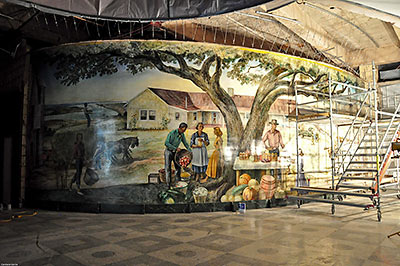
Note: Linbeck has posted a response, which we’ve now included at the bottom of this story.
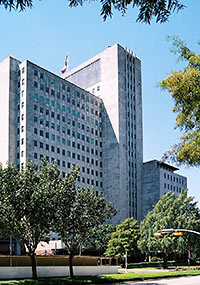 If everything goes well, the giant ranch-scene mural by artist Peter Hurd that’s stood in the lobby of the M.D. Anderson Cancer Center’s Houston Main Building at 1100 Holcombe in the Medical Center since the structure was built as a Prudential Life Insurance HQ in 1952 will likely qualify as the largest fresco painting ever moved successfully to a new location. A donor is paying more than half a million dollars for the curved 16-by-46-ft. wall painting, appraised for more than $4 million, to be dismantled, preserved, and transferred eventually to a new home in a public library in Artesia, New Mexico, where the artist once had a studio. But at this point it’s not entirely clear that the move will go well, because Linbeck, the contractor hired by the Texas Medical Center institution to manage the enterprise, has fired the mural-conservation consultant who’s been working on the job for more than a year, only days before a looming deadline: the handing over of the famous 18-story building the painting occupies to a demolition contractor.
If everything goes well, the giant ranch-scene mural by artist Peter Hurd that’s stood in the lobby of the M.D. Anderson Cancer Center’s Houston Main Building at 1100 Holcombe in the Medical Center since the structure was built as a Prudential Life Insurance HQ in 1952 will likely qualify as the largest fresco painting ever moved successfully to a new location. A donor is paying more than half a million dollars for the curved 16-by-46-ft. wall painting, appraised for more than $4 million, to be dismantled, preserved, and transferred eventually to a new home in a public library in Artesia, New Mexico, where the artist once had a studio. But at this point it’s not entirely clear that the move will go well, because Linbeck, the contractor hired by the Texas Medical Center institution to manage the enterprise, has fired the mural-conservation consultant who’s been working on the job for more than a year, only days before a looming deadline: the handing over of the famous 18-story building the painting occupies to a demolition contractor.
To move the mural, in January 2010 Linbeck hired Nathan Zakheim Associates, an art conservation firm from California, to develop a complex multi-stage process that included painting the back of the structure with resin and fiberglass and attaching it to massive trusses. Last month, the building’s entrance canopy was demolished to allow enough room for the painting’s exit. The mural was originally scheduled to be out the door before February 11th of this year. But efforts to meet that deadline were stymied by an almost two-and-half-month delay — which one source blames on the engineering firm hired by Linbeck — in the fabrication of the two 9,000-lb. curved steel trusses required for the job. After the trusses were finally delivered on January 10th, the conservator submitted a revised proposal that pushed the move-out date into the first week of March. Linbeck fired Zakheim from the job on January 20th.
“When you fire your conservator and bump up the schedule, it doesn’t mean it’s because you want to do the job right,” a source complains to Swamplot, expressing fears Linbeck will meet its original deadline for getting the mural out of the building — and damage or destroy it in the process. Linbeck would have had to pay additional fees to the conservator in order to keep him on, according to the source, and Linbeck’s contract with M.D. Anderson stipulates financial penalties for construction delays. “They re-read the contract, and the contract does not prohibit them from taking the mural out in crumbled pieces,” explains the source.
The mural was painted to illustrate Prudential Life Insurance’s motto at the time: “The Future Belongs to Those Who Prepare For It.” Linbeck has reportedly expressed confidence to M.D. Anderson and the donor that the company can manage the move successfully without the assistance of the conservator. But to do that, the company will have to overcome a couple of significant obstacles:
***
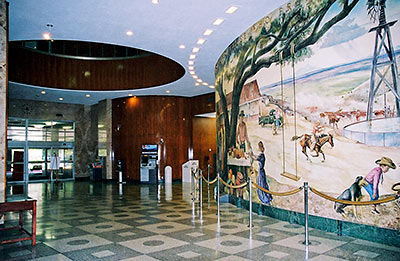
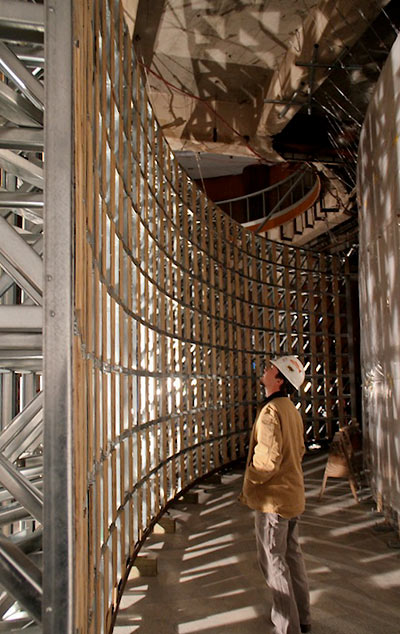
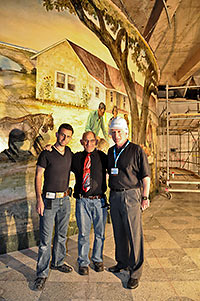 The first is that the final stage of preparation — solidifying the mural by injecting the plaster with a water-thin epoxy so that it won’t crumble when it’s moved — has not been completed. The irregular curvature of the mural will make the supporting plaster highly susceptible to any deflection in the wall during transit. According to documents related to the project provided to Swamplot, that epoxy — which Zakheim bragged to the Chronicle‘s Allan Turner last year would even make it possible to store the structure “at the bottom of the ocean next to that oil well” — is a proprietary formula developed by the firm specifically for this project, and he took it with him when he was fired. To complete the move according to a process developed over the course of a year, it appears Linbeck will need to either develop its own formula within a very short period of time and test it to make sure it will not damage the painting, or move a highly fragile structure without it.
The first is that the final stage of preparation — solidifying the mural by injecting the plaster with a water-thin epoxy so that it won’t crumble when it’s moved — has not been completed. The irregular curvature of the mural will make the supporting plaster highly susceptible to any deflection in the wall during transit. According to documents related to the project provided to Swamplot, that epoxy — which Zakheim bragged to the Chronicle‘s Allan Turner last year would even make it possible to store the structure “at the bottom of the ocean next to that oil well” — is a proprietary formula developed by the firm specifically for this project, and he took it with him when he was fired. To complete the move according to a process developed over the course of a year, it appears Linbeck will need to either develop its own formula within a very short period of time and test it to make sure it will not damage the painting, or move a highly fragile structure without it.
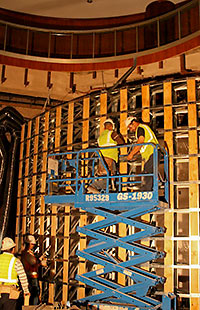 But proceeding on its own may put Linbeck and the organization that hired it in jeopardy of violating the Visual Artists’ Rights Act if the mural is damaged during the move. That federal law, passed in 1990, was designed to protect certain artworks from being distorted, mutilated, or modified, if it also damages the artist’s “honor or reputation.” “If an historic work of art exists within a building to be torn down, and some arrangement has been made for it to be removed and re-located, VARA dictates the level of care mandatory to remove such artwork,” a source familiar with the law tells Swamplot. In the event of damage to the mural, both Linbeck and M.D. Anderson could be sued under the statute; insurance usually does not cover the damages. And Swamplot’s source claims the law does not treat an “oops!” defense lightly.
But proceeding on its own may put Linbeck and the organization that hired it in jeopardy of violating the Visual Artists’ Rights Act if the mural is damaged during the move. That federal law, passed in 1990, was designed to protect certain artworks from being distorted, mutilated, or modified, if it also damages the artist’s “honor or reputation.” “If an historic work of art exists within a building to be torn down, and some arrangement has been made for it to be removed and re-located, VARA dictates the level of care mandatory to remove such artwork,” a source familiar with the law tells Swamplot. In the event of damage to the mural, both Linbeck and M.D. Anderson could be sued under the statute; insurance usually does not cover the damages. And Swamplot’s source claims the law does not treat an “oops!” defense lightly.
A summary of the preparation and moving process, provided to Swamplot:
. . . hang it from anchors in the ceiling with v-shaped supports, and remove a terra cotta wall which marginally supported it from the back. [Then:]
1. Support the front of the mural with a full platform pressed against the front of the mural, separated from the mural with 4″ of soft foam rubber.
2 Drill the back of the mural with 11/4″ diamond core saws to within 1/4 inch of the white surface plaster of the mural (the whole plaster piece is 1″ thick in most places. The holes are place approximately 3″ apart both vertically and horizontally). (6-8 holes per square foot).
3. Scrape out the holes with dental tools, until the drilled part is flat across the bottom of the hole.
4. Saturate the drilled back of he mural with a special hyper low viscosity epoxy mixture. Wait four days for the epoxy to fully set, and the solvents to evaporate.
5. Fill the holes with epoxy paste mixed with fiber filler.
6. Apply layers of fiberglass cloth in a higher viscosity epoxy until a 3/8″ layer is reached.
7. Drag the Truss assembly forward. (14 gauge steel with angled cross bracing 18″ on center) The front and back Truss assemblies weigh over 9,000 lbs each.
8. . . . epoxy the massive Truss assembly to the back of the very strong mural surface, and then cover the back with two layers of plywood laminated together with wood glue.
9. . . . bolt the front foam rubber padded Truss to the back epoxied Truss, and pack for transport by “cushion ride” “low boy” trailer and truck to New Mexico.
And some notes on possible sticking points:
1. If the front truss is pressed too hard against the mural at first, it will crack or shatter the mural.
2. If the drilling is not done in “offset” configurations, sections of the mural could break loose before consolidation, due to the already weak crumbly, mural plaster being further weakened from the drilling.
3. If the wrong epoxy is used, or no epoxy is used, or if no drilling has taken place, then even though fiberglass has been applied to the back of the mural, and 9,000 lbs of structure epoxied to it, nothing will have “glued” the three to four layers of plaster over the expanded metal lath together. (a thin coat of plaster was troweled over the expanded metal lath to create a “bubble through” to hold subsequent layers in place. Then a “Scratch coat” was applied, then a “brown coat” and finally 1/8″ of white finish plaster that was the surface on which the mural was painted.)
At present, all three/four layers of plaster are basically somewhat loose from each other.
So, if [the contractor] does not soak all three layers of plaster with an ultra-thin epoxy, while waiting until the solvent factor evaporates, there will be no attachment between the layers of plaster, and when the front Truss assembly support is removed, the white plaster layer (as well as other layers) could well come off in small pieces as well as sheets. This would be nearly impossible or actually impossible to repair.
Update, 2/2: Linbeck’s response:
The work to remove and preserve the Peter Hurd mural at the The University of Texas M D Anderson Cancer Center is being undertaken with the skill and care worthy of this significant work of art. Linbeck Group, LLC is proud to be coordinating the preservation of a mural that has enriched the lives of tens of thousands of visitors to the building.
Linbeck does not publicly discuss its business relationship with any contractor or vendor. The terms of Linbeck’s agreement with the former conservator are a private business matter.
The conservator currently engaged in the preservation of the mural is an eminently qualified authority who is well-regarded for their work in the art conservation and museum communities. This conservator is recognized by the American and the International Institutes for Conservation of Historic and Artistic Works. Their successful preservation projects include work with the J. Paul Getty Museum, the Houston Museum of Fine Arts and the National Gallery of Art in Washington.
Linbeck is collaborating with the conservator and other subcontractors to ensure the mural will be secure throughout the removal process. Linbeck anticipates removal of the fresco will be completed in the first quarter of this year.
- Medical center mural saved [Houston Chronicle]
- Previously on Swamplot: The Prudential Tower’s Grand Entrance, Before Its Not-so-Grand Exit, Update: M.D. Anderson Not Demolishing Former Prudential Tower Yet, Just Hacking Away at It a Bit, Report: M.D. Anderson Begins Demolishing Med Center Icon
Photos: Candace Garcia (mural preparation; 1100 Holcombe Blvd.; Kuvalesaya and Nathan Zakheim of Zakheim Associates and Linbeck’s Joel Kaufman in November); Karen Lantz (original lobby); Swamplot inbox (trusses),





Wow! There’s actually a federal law to protect art installations in buildings scheduled for demolition? How on earth did that get past the “smash it if it can’t pay for itself, property rights at all costs crowd?” And during a Republican administration at that? Oh, wait, it was during the heady days following the fall of the Berlin Wall and the first Persian Gulf War. America could do anything, even rescue endangered artworks!
Great story – intrigue and technology!
This removal is complex and expensive but Linbeck gets a feather in its cap for doing the right thing… so get the conservator back already!
or I’m gonna glue myself to the thing and stage a sit-in I mean hang-in.
I hope they pull it off successfully. No pun intended.
I know that the law requires the property owner to contact the artist before destroying the artwork so that it can be moved if the artist wishes. Whose responsibility it is to pay is beyond my understanding of the statute. Kent Twitchell’s Ed Ruscha mural in downtown LA is the biggest settlement as a result of it to date I think although that was based on the owner not informing the artist before painting over it.
Definitely seems fishy that they would fire Zakheim. I was under the impression that they were pretty much the people to go to for that sort of project.
I have a bad feeling about this.
… and isn’t ‘wafer-thin’ the usual term??
I used to work at the Prudential Building and always a sight to see. Interesting piece of art.
Would this law have affected the Biggers-mural-gate at TSU?
One waits with baited breath to see what masterpiece WHR or FKP will replace this building with!
I can also only imagine what the lobby art will be…
Maybe they can hire David Adickes to design a bust of C. Everett Koop for the lobby or perhaps the ceremonial passenger drop-off out front!
While they may have contract problems, Linbeck probably has nothing to worry about from the Visual Artists Rights Act. Peter Hurd died in 1984, and all rights under VARA died with him, unless there was a co-artist.
I’ll save Linbeck some time on figuring out that epoxy formula. 1 part day-old scrambled eggs residue + 2 parts burned rice and finally 1 part dried tomato sauce. If they need to conduct a tensile strength test, my kitchen sink is available for rent.
This ought to be good.
I want to hear more about the January 20th firing of Zakheim…like Jimbo mentioned, something seems off here..
Nothing seems off to me with the firing. You have a firm that was supposed to meet a deadline, failed to do so (whether their direct fault or sub that they manage, it is still their responsibility), and then presented a request/demand for additional fees with a time schedule of an additional 8 weeks. You would also have to question at what point they knew they were going to be late to that extent also, not likely that they suddenly woke up in mid January and realized they were not going to meet the deadline in a few weeks. The Contractor is the one who would face the penalties from the Owner for being late, not the firm, so they have to do what they can to meet the schedule.
If it was the sub that Linbeck hired as mentioned in the story it would be interesting to know whether Zakheim had much control over them.
The work to remove and preserve the Peter Hurd mural at the The University of Texas M D Anderson Cancer Center is being undertaken with the skill and care worthy of this significant work of art. Linbeck Group, LLC is proud to be coordinating the preservation of a mural that has enriched the lives of tens of thousands of visitors to the building.
Linbeck does not publicly discuss its business relationship with any contractor or vendor. The terms of Linbeck’s agreement with the former conservator are a private business matter.
The conservator currently engaged in the preservation of the mural is an eminently qualified authority who is well-regarded for their work in the art conservation and museum communities. This conservator is recognized by the American and the International Institutes for Conservation of Historic and Artistic Works. Their successful preservation projects include work with the J. Paul Getty Museum, the Houston Museum of Fine Arts and the National Gallery of Art in Washington.
Linbeck is collaborating with the conservator and other subcontractors to ensure the mural will be secure throughout the removal process. Linbeck anticipates removal of the fresco will be completed in the first quarter of this year.
Linbeck Response
Was that “Linbeck response” cc’d to the Swamplot inbox from a Linbeck email address? Just sayin’..
@Lauren: Yes it was. And we’ve added it to the story.
Mmm-hmmm. Zakheim was publicly known, but they won’t name the new conservator? I’m guessing from Linbeck’s rather testy response that they weren’t just real too happy to have Zakheim’s firing become public knowledge.
I’m surprised that no one has mentioned that Leo Linbeck Jr. is on the board of the MD Anderson Foundation – I wonder what sort of process they had for hiring…
There is no conservator on site. This work calls for “hands on work” not cyber advise.
The AIC to whom all professional conservators belong, will not brook the type of “secrecy” that Linbeck seems to revel in.
All methods used in the removal of the fresco are meant to be PUBLIC KNOWLEDGE as the work goes on, according to the Code of Ethics of the AIC.
Hiding the name of the Conservator is also a violation of the Code of Ethics of the AIC.
(American Institute of Conservation)(Easy to Google).
I doubt that the new conservator realized that her name is being kept secret.
Linbeck delayed the project by three months by not delivering the Truss assmblies in time for NZA to remove the mural within schedule.
Then Linbeck asked NZA to “cover” for them by “donating” 70 days of NZA time for no additional Conservation Fee! NZA is complete with all deadlines and Milestones up to the non-delivery of the Trusses to support the mural in November.
Best way to pay for Linbeck’s mistake was to fire the conservator, and pay for the cost of Linbeck’s delay by not paying the conservator’s fee.
Linbeck has already saved a lot of money by “trimming”the conservator’s fee by up to 65% on each pay period
So far, having hired NZA has not cost Linbeck very much, even though NZA custom designed the entire “never before even thought possible” process for removing the Hurd Mural with the design fee included in NZA’s total removal fee. Huge gift to an ungrateful recipient!
The Mural cannot be safely removed unless the plaster itself is hardened first, to seal all three loose layers of plaster together. Otherwise, the loose white plaster with the mural image on it will eventually fall off.
NZA has given its final highly researched samples to Linbeck without response to date. It does not take a genius to understand that the plaster is better off hard like sidewalk cement, rather than crumbly like a dirt clod.
NZA is in Houston, and has the technology to save the mural. What is Linbeck waiting for?
Now, at the most citical point in the removal of the Mural, secrecy of method is the last thing the Mural needs!
Full disclosure is required.
NZ of NZA
When a new conservator takes over a project from a Conservator who custom designed the project from the start,The first thing any Museum Quality Conservator would do is to contact the previous Conservator and go over his existing plans in minute detail.
No reputable conservator will take up an “on the verge of being finished” project cold, and with no idea or insight into the thinking that went into the first Conservator’s finely detailed plan of action, plunge ahead with an unrelated plan.
This leads one to conclude that there is no on site conservator at all. The confidentiality clause and proprietary methodology clause in NZA’s contract with Linbeck, would absolutely prohibit Linbeck from even showing NZA’s Conservation plan to the new Conservator.
No, AIC Ethics demands transparent full disclosure.
ees!
Linbeck did not terminate NZA’s contract for poor performance.They simply wanted to save money.(They are broadcasting that “it is all about money”. Since NZA’s plan for now until the end of the project has not been questioned, then the new Conservator would no doubt be urgently seeking a meeting with NZA, who is still in Houston. The “new Conservator” is largely a myth.
Most Conservators charge at least double the fees of NZA. Since it was “all about money” Linbeck is hardly going to pay their new conservator double the rate of NZA, considering it was the cost of NZA completing the project that motivated the Termination of NZA’s contract with Linbeck.
The Mural will certainly come out of the building. The question is: How many pieces will be in the box?
Since the mural is to be stored for at least two years, perhaps at that time no-one will be interested or concerned if the mural was smashed to pieces two years before.
Of course, by then, Linbeck will have been fully paid, and gone on to bigger and better things.
Linbeck should reveal the front of the Mural before the Mural goes into storage.
NZ of NZA
@NZ
This is very upsetting & disappointing.
You seem to know the new conservator.
?
Curious minds want to know…
What is happeneing to preserve this mural?
.
You have so successfully championed preservation, and not just of your father’s works; you’re a central person in american conservation.
.
I’d like to learn more:
movocelot@gmail.com
From Conflict?: I’m surprised that no one has mentioned that Leo Linbeck Jr. is on the board of the MD Anderson Foundation – I wonder what sort of process they had for hiring… February 2, 2011 at 5:22 pm
^^^
The M. D. Anderson Foundation is a completely separate entity from The University of Texas MD Anderson Cancer Center. Like the foundation, the cancer center merely bears the name of the donor whose 1939 bequest helped establish it.